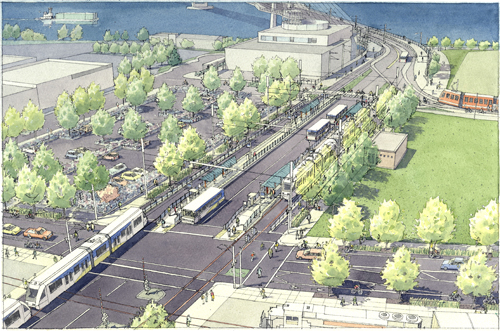It will be called the Orange line: TriMet’s new Portland-Milwaukie MAX light rail line, projected to open in September 2015, will extend from Southwest Fifth Avenue and Jackson Street, at the south end of the Portland State campus, to Southeast Park Avenue in Milwaukie. In addition to a new bridge to carry the trains across the Willamette, the new line will also have 18 new trains.
TriMet orders 18 new trains for Portland–Milwaukie light rail line
It will be called the Orange line: TriMet’s new Portland-Milwaukie MAX light rail line, projected to open in September 2015, will extend from Southwest Fifth Avenue and Jackson Street, at the south end of the Portland State campus, to Southeast Park Avenue in Milwaukie. In addition to a new bridge to carry the trains across the Willamette, the new line will also have 18 new trains.

According to TriMet Chief Media Relations Officer Mary Fetsch, MAX currently covers a total of 33 service miles and has a fleet of 127 MAX trains. The Portland-Milwaukie Light Rail Transit Project will add an additional 7.3 miles, and TriMet will buy 18 new Type 5 light rail vehicles.
“More miles traveled means you need more trains to provide the service,” Fetsch said.
These new Type 5 LRVs are made primarily in the United States by Munich-based Siemens Corporation, which manufactures and buys the majority of components to assemble the trains. Each Type 5 LRV costs approximately $4 million, and Siemens will deliver each one separately. According to TriMet, it will put each train through a rigorous 1,000-mile testing and “burn-in” period before it goes into service.
A fact sheet provided by Fetsch indicates that on the outside, these new trains are very similar to the current Type 4 MAX train, but have a number of new features: more energy efficient interior lighting, improved heating and air conditioning, digital instead of analog cameras and improved ramps for better accessibility.
In an article published in The Oregonian on April 6, Joseph Rose wrote about complaints he and others from Portland have regarding the leg room and seating on the current Type 4 MAX. According to a TriMet statement, it is looking to solve this problem: “TriMet is exploring the reconfiguration of seating on Type 5 LRVs.”
The new line includes 10 new stops in total, two on the west side of the Willamette and eight on the east side. The downtown stops will be at Southwest Third Avenue and Lincoln Street and at the South Waterfront at Southwest Moody Avenue.
An elevated structure will connect the two stops. TriMet calls it the Harbor Drive Structure, and it will extend over Southwest Harbor Drive and travel under the Interstate-5 and Interstate-405 ramps to get to the South Waterfront area. According to TriMet, the structure will be closed to all non-MAX traffic, including pedestrians and bicyclists.
Knowing where the line will go is an important aspect of the project, because it has potential to bring a lot to the proposed area. According to residents, the new MAX line to Milwaukie is important for the community there. Park Avenue, where the line will stop, is located just south of Milwaukie in Oak Grove.
Fred Nelligan, the Oak Grove representative on the TriMet Portland-Milwaukie light rail Citizens Advisory Committee, said that in the past three years, things in the Oak Grove area have been changing.
“There’s so much dynamic energy and passion and community…really tying both the residential and the business community of McLoughlin Boulevard together,” Nelligan said. “My personal opinion is that this is primarily because of the MAX line from Portland to Oak Grove at Park Avenue”
Nelligan said that Milwaukie, and the cities around it, have really been screaming for light rail service of some sort to connect northern Clackamas County with the Portland metropolitan area.
“I feel like it’s going to bring a lot more people to the area. And I think it might help out the local businesses there, because right now Milwaukie’s kind of dead,” said PSU science junior Rusne Kuzmickas, who lives in the Oak Grove area and takes the 33 bus line to get to school.
“I think a lot of people that live in Milwaukie don’t want that, because they live there because it’s way quieter, but I think it’s a good thing. I take the bus every day, and I would much rather take the MAX.”
“[The] project has been in the planning, design and construction phase for about 12 years,” Fetsch said. She added that this region was selected because it has priority to expand high-capacity transit.
The project is estimated to cost a total of $1.49 billion. Fetsch said that 50 percent of the funding comes from federal funds and about 45 percent from state, regional and local funds; TriMet’s share is less than 5 percent.





Excellent goods from you, man. I have bear in mind your stuff previous to and you are simply extremely magnificent. I actually like what you’ve got here, really like what you are saying and the way through which you say it. You make it enjoyable and you still care for to stay it wise. I can not wait to read far more from you. This is actually a tremendous site.